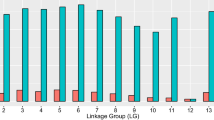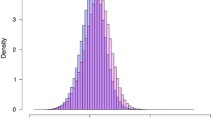Abstract
The genetic control of 11 electrophoretically detected allozyme polymorphisms in the oysterCrassostrea virginica was investigated in 10 pair crosses. For nine allozyme loci, each offspring shared at least one band (electromorph) with each parent. For the remaining two loci (mannosephosphate isomerase and leucine aminopeptidase-2), some offspring failed to share a band with one or both parents. Several lines of evidence indicated that these anomalous results were due to transmission of null alleles. There was evidence of distorted segregation at 8 of the 11 loci. The departures from the Mendelian expectations within the pair crosses might be due either to viability selection in the offspring or to gametic selection in one or both parents, although the possibility that the distortion is due to a locus linked to the allozyme locus cannot be ruled out. However, there was no evidence that heterozygosity per se had an effect on viability of offspring within a cross. Linkage analysis revealed two linkage groups, one consisting of four allozyme loci and the other consisting of three loci.
Similar content being viewed by others
References
Beaumont, A. R., Beveridge, C. M., and Budd, M. D. (1983). Selection and heterozygosity within single families of the musselMytilus edulis (L.).Mar. Biol. Lett. 4151.
Berger, E. M. (1983). Population genetics of marine gastropods and bivalves. In Russell-Hunter, W. D. (ed.),The Mollusca, Vol. 6. Ecology Academic Press, New York, pp. 563–596.
Buroker, N. E. (1983). Population genetics of the American oysterCrassostrea virginica along the Atlantic coast and the Gulf of Mexico.Mar. Biol. 7599.
Buroker, N. E., Hershberger, W. K., and Chew, K. K. (1975). Genetic variation in the Pacific oyster,Crassostrea gigas.J. Fish. Res. Board Can. 322471.
Elandt-Johnson, R. C. (1971).Probability Models and Statistical Methods in Genetics. Wiley, New York.
Fairbairn, D. J., and Roff, D. A. (1980). Testing genetic models of isozyme variability without breeding data: Can we depend on thex 2?Can. J. Fish. Aquat. Sci. 371149.
Foltz, D. W. (1986). Null alleles as a possible cause of heterozygote deficiencies in the oysterCrassostrea virginica and other bivalves.Evolution 40869.
Foltz, D. W., and Chatry, M. (1986). Genetic heterozygosity and growth rate in Louisiana oysters (Crassostrea virginica).Aquaculture (in press).
Foltz, D. W., Newkirk, G. F., and Zouros, E. (1983). Genetics of growth rate in the American oyster: Absence of interactions among enzyme loci.Aquaculture 33157.
Gaffney, P. M., and Scott, T. M. (1984). Genetic heterozygosity and production traits in natural and hatchery populations of bivalves.Aquaculture 42289.
Hvilsom, M. M., and Theisen, B. F. (1984). Inheritance of allozyme variations through crossing experiments with the blue mussel,Mytilus edulis L.Hereditas 1011.
Lannan, J. E. (1980). Broodstock management ofCrassostrea gigas I. Genetic and environmental variation in survival in the larval rearing system.Aquaculture 21323.
Lewontin, R. C. (1974).The Genetic Basis of Evolutionary Change Columbia University Press, New York.
Newkirk, G. F., Haley, L. E., Waugh, D. L., and Doyle, R. (1977). Genetics of larvae and spat growth rate in the oysterCrassostrea virginica.Mar. Biol. 4149.
Nordheim, E. V., O'Malley, D. M., and Guries, R. P. (1983). Estimation of recombination frequency in genetic linkage studies.Theor. Appl. Genet. 66313.
Schaal, B. A., and Anderson, W. W. (1974). An outline of techniques for starch gel electrophoresis of enzymes from the American oysterCrassostrea virginica Gmelin.Georgia Mar. Sci. Cent. Tech. Rep. Ser. 74(3):1.
Singh, S. M., and Green, R. H. (1984). Excess of allozyme homozygosity in marine molluscs and its possible biological significance.Malacologia 25569.
Wada, K. T. (1975). Electrophoretic variants of leucine aminopeptidase of the Japanese pearl oysterPinctada fucata (Gould).Bull. Nat. Pearl Res. Lab. Jap. 192152.
Wilkins, N. P. (1976). Genic variability in marine Bivalvia: Implications and applications in molluscan mariculture. In Persoone, G., and Jaspers, E. (eds.),Proceedings of the Tenth European Symposium on Marine Biology, Vol. 1, Mariculture Universa Press, Wetteren, Belgium, pp. 549–563.
Zouros, E., and Foltz, D. W. (1984). Possible explanations of heterozygote deficiency in bivalve molluscs.Malacologia 25583.
Zouros, E., Singh, S. M., and Miles, H. E. (1980). Growth rate in oysters: An overdominant phenotype and its possible explanations.Evolution 34856.
Zouros, E., Singh, S. M., Foltz, D. W., and Mallet, A. L. (1983). Post-settlement viability in the American oyster (Crassostrea virginica): An overdominant phenotype.Genet. Res. 41259.
Author information
Authors and Affiliations
Additional information
This research was supported by NSF Grant BSR-8407450.
Rights and permissions
About this article
Cite this article
Foltz, D.W. Segregation and linkage studies of allozyme loci in pair crosses of the oysterCrassostrea virginica . Biochem Genet 24, 941–956 (1986). https://doi.org/10.1007/BF00554530
Received:
Revised:
Issue Date:
DOI: https://doi.org/10.1007/BF00554530




